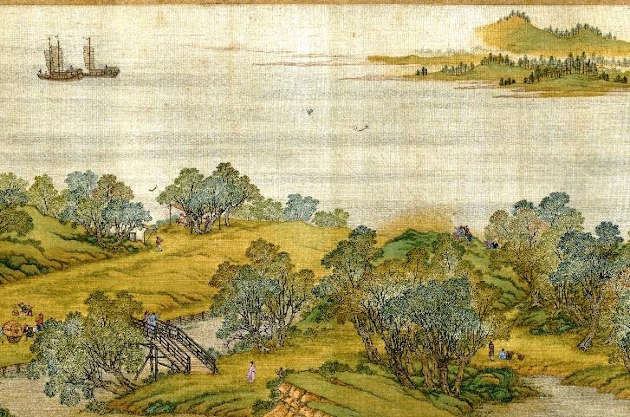Scroll Left, But Take Your Time

As people return to campus after sheltering in place for the COVID-19 outbreak, they are likely to notice a new art installation, Spring Festival Along the River, in the display case across from the elevators on the first floor near the Executive Education wing in the southeast corner of the JSOM I building. The art on display here is a reproduction of a Qing dynasty scroll painting that was itself a reproduction of a Song dynasty scroll painting known as Qing Ming Shang He Tu (清明上河圖, Along the River During the Qingming Festival), by the artist Zhang Zeduan (張擇端), from the early 12th century.
The original scroll depicts various idealized scenes of life along the banks of a river — purported to be the Bian River in the city of Kaifeng, the Northern Song capital, and perhaps during a festival — though these two points have been the subject of ongoing scholarly debate.
Dr. Jacqueline Chao, senior curator of Asian art at the Crow Museum of Asian Art (the family of Trammell and Margaret Crow donated the museum’s entire collection, along with $23 million in support funding, to UT Dallas in January 2019), put the scroll into context in terms of Asian art history.
The Chinese Mona Lisa
Done primarily in monochrome ink on silk, the original scroll, which is housed in the Palace Museum in Beijing, is over 800 years old. It therefore is relegated to climate-controlled storage and brought out for only brief viewings every few years. It is considered a masterpiece of Chinese scrolls — the Chinese Mona Lisa, as it were, and, as such, has attracted attention from artists and historians the world over. In China, copying another artist’s work is a legitimate art form unto itself, and the iconic scroll has been the subject of myriad reproductions and interpretations by countless artists throughout the centuries.
One such reproduction, currently in the collection at the National Palace Museum in Taipei, is an artistic interpretation of the original that was completed in 1736 by five court painters of the Emperor Qianlong of the Qing dynasty (1644-1911): Chen Mei (陳枚), Sun Hu (孫祜), Jin Kun (金昆), Dai Hong (戴洪) and Cheng Zhidao (程志道).
When asked what made that version unique, Chao said, “I’d say it is the aesthetics — its vibrant colors and a flattening of the composition that adjusted perspective, making the subject more proportional and accurate to the eye. Such changes are indicative of western one-point influence, likely reflecting what was seen at court at the time, through interactions with Jesuits and other Europeans, and observation of their painting techniques.”
Good Views, Rarely Seen
The handscroll on display in JSOM, as part of the Jindal Art Collection, is one of many similar reproductions of the Qing dynasty interpretation. “What makes this one special,” Chao said, “is that it is a very good reproduction of a scroll that is rarely seen, and is true to size to the one in Taipei.”

Chinese handscroll paintings are meant to be viewed gradually from right to left in portions equivalent to a shoulder’s width apart, such that viewers come across elements in a certain linear order as they slowly unroll the scroll. The Jindal School exhibit opens with the far-right portion of the scroll visible; the scroll will be periodically unrolled and repositioned so that the entire scroll can be viewed scene by scene in regular intervals over the course of several months. In this way, viewers can experience the scroll as originally intended.
With travel limited and so many museums temporarily closed, having this scroll in JSOM provides a unique, limited-time opportunity for a museum-quality encounter. For art enthusiasts and others interested in further reading on the subject, Chao offered these references:
- The Qingming Scroll
- The Beijing Qingming Scroll and Its Significance for the Study of Chinese History
- A Special Exhibition of Paintings on “Up the River During Qingming” in the Museum Collection – National Palace Museum
This 2016 exhibition in the National Palace Museum in Taiwan showed later Qing dynasty versions of the scroll.





